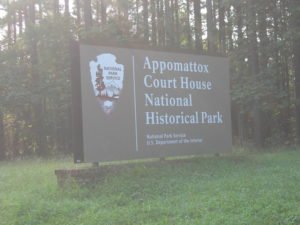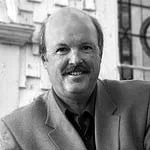Once I spent an afternoon at Appomattox walking the Via Dolorosa of the Confederacy. The Richmond-Lynchburg Stage Road is mostly just a trace now but this is the scene of the last march. Here’s where Bobby Lee rested beneath an apple tree (Gethsemane) waiting for word from Grant. Here’s where he met his troops after the surrender (And Lee wept). Here’s the long hill to the surrender ground lined with Union troops—ordered by Chamberlain to offer a profound salute to the beaten rebels.
It’s all here in Appomattox—the gracious, merciful victors and the humble, honorable Confederates. A town preserved so perfectly in amber that every lawn is cut with the same precision and every fence post in place. The slave quarters converted to bathrooms—(I know.) The old village is so far removed from modern Appomattox now that there is nothing in Appomattox, the dreamscape, to disturb the illusion that anything other than magnanimity and comity ever came from here.
The National Historical Park is a wretched place to imagine anything other than the Lost Cause because it is the American pastoral ideal. America is supposed to be a place of quiet beauty nestled on rolling hills. There are supposed to be green pastures and hard-working, well-intentioned people. There must be solid-looking courthouses and white picket fences, a road that winds around a bend and over the hill. If Appomattox is as it is, then why was war ever necessary at all? If Lee and Grant had so much respect for each other, why did we fight?
Appomattox is a place to be reassured that we got it all right in the end. Bucolic settings can be our destiny because inevitably we shake hands and go home—even the defeated with their own mules and horses.
But the march across the Edmund Pettis bridge came to mind as I walked the Stage Road. Another solemn journey toward a phalanx of former and current hostiles. The surrender march in ’65 ended nothing. Surrender, hell! The demons just went back to Southside and beyond, licked their wounds and nursed their grievances. Sanctioned, quarantined violence against blacks became democratic, profligate, wink-and-a-nod violence. Every effort to make a change was fought with snarling, whinging fury because ‘they want to change our way of life.’
I’m guilty as charged, no doubt. The Lost Cause sunk its hooks in me as a white Virginia teenager, just as many another besetting sin has done. It is some small sign of grace that now easy answers like Appomattox the Beautiful offend me. The texture of the real village is more burlap than what I saw. With its ragged weave, burlap offers what rayon cannot. In some small ways it lets the light shine through.


Share this post with your friends.

